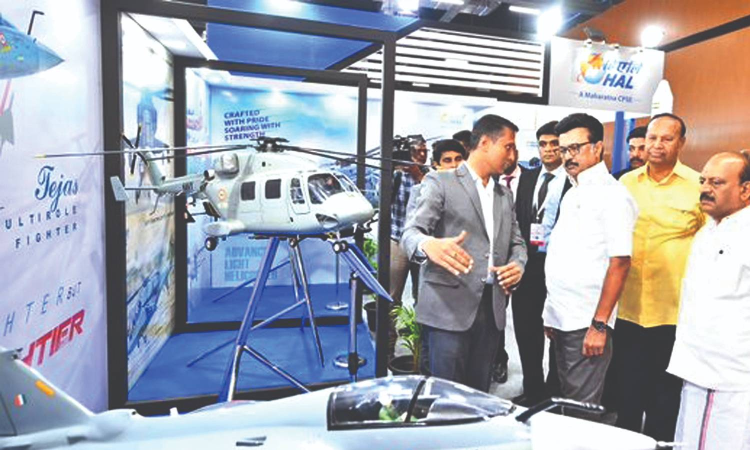Tamil Nadu is an ideal partner for defence innovation, says DRDO official BK Das
On the sidelines of AeroDefCon 2025 at the Chennai Trade Centre, BK Das, Distinguished Scientist and Director General (Electronics and Communication Systems), shared his insights with DT Next on India's evolving defence ecosystem, the vision behind DRDO 2.0, and how States like Tamil Nadu are emerging as key innovation hubs in the national defence roadmap.

CHENNAI: As India charts its course towards becoming a Viksit Bharat by 2047, the Defence Research and Development Organisation (DRDO) is leading the charge in building cutting-edge indigenous technologies. On the sidelines of AeroDefCon 2025 at the Chennai Trade Centre, BK Das, Distinguished Scientist and Director General (Electronics and Communication Systems), shared his insights with DT Next on India's evolving defence ecosystem, the vision behind DRDO 2.0, and how States like Tamil Nadu are emerging as key innovation hubs in the national defence roadmap.
Excerpts…
Q: What are the key steps taken by DRDO to achieve the vision of Viksit Bharat by 2047?
A: A nation truly becomes Viksit when it believes in its own capabilities and when its armed forces place full trust in homegrown systems. India is witnessing a transformation; we saw it during Operation Sindoor, where our defence forces relied entirely on indigenous platforms. This reflects a strong sense of confidence in our technology and design capabilities. We have outlined a 20-year roadmap that brings together academia, startups, and industry to co-develop advanced defence systems. The focus is on designing next-generation, globally competitive technologies that can't be found anywhere else. As we enhance self-reliance, our export potential will grow exponentially. Our goal aligns with India's USD 10-trillion economy vision, and a robust defence manufacturing base will be a cornerstone of that growth.
Q: How is DRDO working with startups and industries under this new ecosystem?
A: The mindset has completely changed. Earlier, industries waited for DRDO projects; now they proactively come to us to join the Design, Development and Production Partnership (DCPP) model. Every startup and MSME is playing a pivotal role in developing niche technologies. This partnership ensures rapid innovation and the realisation of world-class systems. Our collaborations are not limited to big players; we want grassroots innovators to participate in building India's defence capabilities. When you trust your own people, the innovation pipeline expands, and the nation gains both strategic autonomy and export strength.
Q: Tamil Nadu has become a major defence hub. How do you view DRDO's collaboration with the State?
A: Tamil Nadu is an ideal partner for defence innovation. The State offers a robust industrial base, strong infrastructure, strategic ports, and a progressive administration. The Defence Industrial Corridor, with an investment of over Rs 23,000 crore, is already driving momentum. We plan to establish component manufacturing units, design centres, and testing facilities here. The cooperative ecosystem in Tamil Nadu will help us materialise many of our ambitious projects. Together, we will convert ideas into impactful technologies.
Q: What does DRDO 2.0 signify, and which technologies are you prioritising?
A: DRDO 2.0 represents a transformational shift, from conventional defence R&D to disruptive innovation. Our focus areas include directed-energy weapons, photonic radars, quantum communication systems, AI-driven decision tools, and autonomous platforms. We are laying the groundwork today for breakthroughs that will define the next two decades. As I often say, we are preparing the ingredients for a future pizza, the foundation is being built now, and the results will be realised in the coming years. India is on the path to becoming a global leader in defence technology. With the collective strength of industry, youth, and academia, we will not just match global standards, we will set them.
AeroDefCon 2025 SNIPPETS
TCL showcases advanced protective defence gear
Troop Comforts Limited (TCL), an ordnance clothing factory under the Government of India and the country's largest garment manufacturer for defence forces and law enforcement agencies, showcased its extensive range of advanced protective gear and tactical apparel at the AeroDefCon 2025. The company's display featured state-of-the-art bulletproof jackets, VIP protection vests, riot-control helmets, bulletproof vehicles, and specially designed jackets for canines deployed in security operations. In addition, TCL exhibited its latest line of ballistic vehicles, protective suitcases, combat uniforms, safety equipment, and a wide range of high-performance defence gear. According to officials, the demand for bulletproof jackets, helmets, and vests has significantly increased in recent years, driven by evolving security challenges and the growing emphasis on personnel safety across defence and paramilitary forces.
Enlite exhibits unmanned state-of-the-art choppers
Enlite Helicopters showcased its cutting-edge unmanned aerial model at AeroDefCon 2025, featuring an array of advanced specifications and autonomous capabilities. The state-of-the-art helicopter boasts a cargo capacity of 70 kg, a range of 500 km, and a maximum speed of 200 km/hr. It offers an impressive endurance of three hours and a turnaround time of just 10 minutes, enabling rapid deployment for diverse operational needs. Equipped with fully autonomous flight capabilities, the helicopter features obstacle avoidance and terrain-following technology that automatically adjusts altitude to match field elevation. It is powered by primary GPS navigation with inertial navigation backup, ensuring seamless accuracy even in challenging environments. For communication, the aircraft is integrated with C2 links via long-range RF, 4G/5G, and SATCOM, providing robust connectivity across multiple networks. Additionally, it is secured with end-to-end data encryption, ensuring safe and reliable mission operations.



